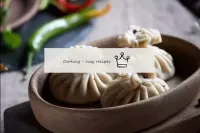Dough simple on wheat flour and water
 16 servings
16 servings1 hour
1. Sift into a bowl of flour.
2. Gradually add salted water to room temperature, knead the dough. Do not rush to top up excess water, rub well with your hands, making as if crumbs.
3. When the flour is not left in the bowl, and the dough crumb has turned out, start moulding a smooth dough - press the dough hard into the bottom of the bowl, giving the surface a flat shape. Tighten the dough with film and let it rest. Usually, while the filling is being prepared, the test of this time is enough.
4. Now make round blanks for khinkali, dough for them needs thin, diameter - about 15-20 cm. You can first roll the dough thick, cut out the mugs with a cup and then roll out thinly, or you can immediately roll thinly and cut out the desired dimension.
5. Now blind the khinkali. To do this, put the blank on a saucer (so that the juice from the filling does not spread) and, creating folds around the edge, pinch the entire edge so that a bag is obtained. There are 19 folds in real khinkali. Squeeze well, pinch off the excess and treat the crais.
6. Hinkali is boiled in boiling water. A tablespoon of salt is placed on a liter of water, then khinkali is laid out, the lid is closed. The entire cooking process is about 10 minutes. Chefs do not look at time, but look at foam. Foam appeared - they cook for another 2-3 minutes, then add cold water to stop boiling, and remove khinkali from the water using a spoon. It is served as it is, and when it is eaten, everyone tastes like khinkali with black ground pepper. They eat with their hands, hold their tail. The ponytail is not eaten. Nice!
Wheat flour - 2 kg, Water - 800 ml, Salt - 35 g
 Español
Español Français
Français Português
Português Русский
Русский 简体中文
简体中文 繁體中文
繁體中文 日本語
日本語 한국어
한국어 العربية
العربية Türkçe
Türkçe Қазақ
Қазақ Deutsch
Deutsch Italiano
Italiano Українська
Українська
